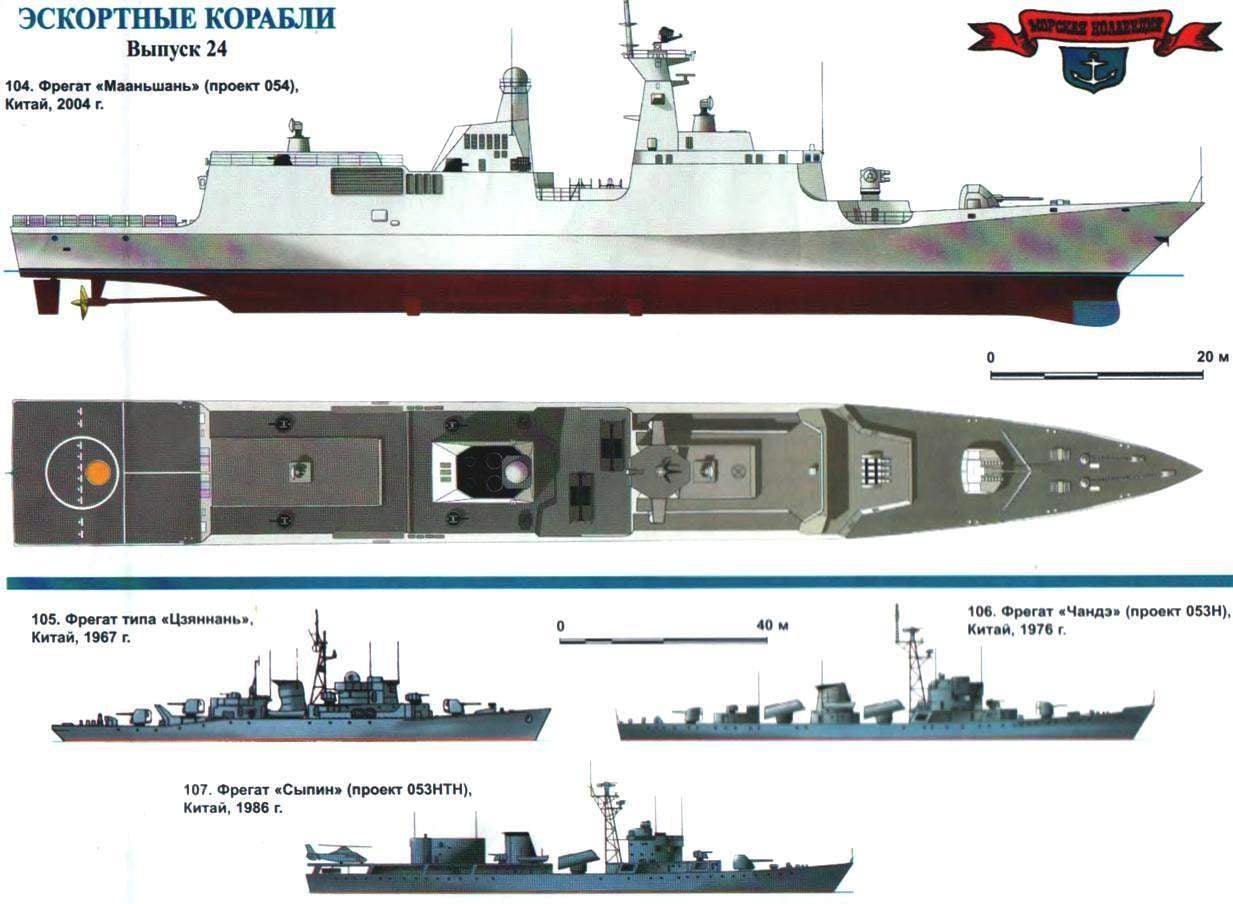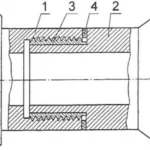 In the English language has long existed a popular expression “Chinese copy” (“Chinese copy”), meaning illegal the repetition of any industrial product without purchasing a license for its production. But for the 50-year history of military shipbuilding of China, this expression is very true in its literal translation. To this day, almost all combat units of the Chinese Navy are a patchwork of units and systems, carefully copied from Soviet or Western models.
In the English language has long existed a popular expression “Chinese copy” (“Chinese copy”), meaning illegal the repetition of any industrial product without purchasing a license for its production. But for the 50-year history of military shipbuilding of China, this expression is very true in its literal translation. To this day, almost all combat units of the Chinese Navy are a patchwork of units and systems, carefully copied from Soviet or Western models.
The first relatively large ships that were built in socialist China, has become the four frigates of the “Guiyang”, which was an exact repetition of our “fifties” — TFR project 50 (see “modelist-Konstruktor” No. 5 for 2004). They were built at shipyards in Shanghai and Guangzhou, arrived under the leadership of the Soviet engineers, the Soviet documentation and fully equipped with, again, Soviet “filling”. Frigates were named after cities of China (tradition to give all the major combat ships “geographical” names of the Chinese follow to this day) and in 1958 — 1959 was put into operation. In the early 1970s they were replaced: instead of torpedo tubes they got dvuhkonturniy rotary launcher for anti-submarine missiles “Haiying” (copy of the Soviet P-15). Along with upgraded in the same way the destroyers-“seven” frigates of the “Guiyang” became the first seagoing submarines of the Navy of China.
Successful project 50 was the basis for the development of the own ship, known in the West as a type of “Jiangnan”. It largely resembled the Soviet “fifty dollars”, but was thoroughly re-designed. Instead of a steam turbine power plant the Chinese have established more than easy to operate diesel engines. The hull of the frigate received a lengthened forecastle; three 100-mm guns B-34 is now located as if “mirror”; two in the stern and one in the nose. Air defenses have increased due to the increase in the number of stems 37-mm guns and add heavy machine guns. Avionics and fire control system remains the same, but from a torpedo weapons abandoned — as it turned out, in vain: it is the site for torpedo tubes in the future become thereby a reserve, which allowed to establish anti-ship missiles. The dense layout of the ships of the “Jiangnan” in the absence of any supply of tonnage was not given the opportunity to turn the frigate into a missile.
Designing and building “zanana” strongly detained began in China the “cultural revolution” — they came into operation only in 1967 -1969 years and by that time hopelessly outdated. It should be noted that accurate information on these ships is still missing — while Maoist China was firmly fenced off from the world. Foreign specialists to this day do not know any of their real names (“Jiangnan” is just the name Shanghai shipyard, which was built head frigate), neither the project number nor the detailed performance characteristics. Even the number of ships in the series to appreciate different ways: they were either five, or six… In the Western press flashed a message that in 1974, during the operation to seize the Spratly Islands in the South China sea, the South Vietnamese Navy sunk one of the frigates of the “Jiangnan”. China, of course, this information is not officially confirmed. But, anyway, the first major operation of the Chinese Navy in distant waters was successful: the Spratly Islands, better known as the archipelago of the Nansha Islands belong to China. Without seaworthy surface ships to implement it would have been impossible.
Successors “zanana” were numerous (40 units of various modifications) ships project 053, leading descended from the same Soviet prototype. Their resemblance to “fifty dollars”, as they say, visible to the naked eye — just look at the flush-deck hull with high sheer and the characteristic collapse of the nasal frames… the Frigates were built in two variants: as the carrier strike missile (project 053Н, Western notation “Csango”) and as air defense ships (project 053J, or “Ningbo”). Alas, with the latter, the Chinese suffered a complete fiasco: the trials of anti-aircraft missiles of their own design dragged on for years, but have not produced satisfactory results. It became clear that the creation of a complex modern weapons systems, the Chinese industry still can not handle. And both built by the project of the frigate 053J all his subsequent service was carrying no missiles, such as pure artillery ships. That is, if the Soviet patrol project 50 came too late to be born for 10 years — 15, they are Chinese descendants — at least 30!
However, “anti -” version of the draft 053Н was more or less successful. Frigates of this type were armed with two twin launchers for launching missiles “Haiying” or “Haiying-2”, as well as versatile artillery of 100-mm and 37-mm caliber. All installed on-Board weapons, radars, command-ranging posts (KDP) were the exact copies of Soviet models 40 — 50-ies of XX century. Or, at least, their modifications — for example, the coupled 100-mm artillery systems, which has equipped the ships of the series was based on old Soviet gun B-34 and had a manual loading that at the time of their appearance on the Chinese ships look anachronistic.
The frigates of project 053Н was built over 20 years: head “Changde” was put into operation in 1976 and the last in the series — in 1996. In the Chinese Navy went 27 of these frigates, three more were built for export to Egypt and Bangladesh, the Last representatives of the family was equipped with an enhanced (but still pretty old) electronic equipment and new twin 37-mm machine guns with electro-hydraulic drive guidance mechanisms. Another ship — “siping” was built in 1986 on the draft 053НТН. From his brethren he was distinguished by the presence of the hangar and airstrip for helicopter Z-9A (manufactured at the factory in Harbin, the license of the French “Dauphin”), for which he had to pay one rocket PU “Haiying-2” and part of the artillery. In addition, the “Rash-not” installed two three-pipe apparatus for anti-submarine torpedoes Yu-7 (copy of the us MK 46 Mod.1), new control tower, and instead of 100 mm Sparky — a copy of the more modern French automatic artillery systems of the same caliber.

104. The frigate “mA’anshan” (project 054), China, 2004.
Built in Shanghai. Full displacement of about 3500 T. maximum Length 112 m, width 13 m, draft 3 m. the average Power two-shaft diesel installation 23 674 HP, speed 26 knots. Armament: 4 PU pnrm. “Inzz-83”, 1×8 PU SAM “Hongqi-7” (“Nawal Krotal”), one 100-mm automatic gun mount, four 30-mm six-barreled AK-630M, 2×2 324-mm ASW torpedo tubes, two RBU type 87, one helicopter Ka-28. In 2004 built 2 units.
105. Frigate of the “Jiangnan”, China, 1967
Built in Shanghai. The normal displacement of 1200 tons, 1,600 tons full Length overall 91.5 m, width 10.1 m, draught 3.2 m. Capacity twin-shaft diesel installation 16 000 HP, speed 28 knots. Armament: three 100-mm guns B-34, four twin 37-mm automatic At-11, two coaxial 14.5 mm machine guns, two RBU 1200, two mortars. Only in 1967 — 1969 built 5 units.
106. The frigate “Changde” (project 05ЗН), China, 1976
Built in Shanghai. Displacement normal 1425 t, 1700 t full Length the greatest 103,2 m, beam 10.8 m, draft 3,1 m. Capacity twin-shaft diesel installation 16 000 HP speed 25,5 site. Armament: 2×2 PU PC R “Haiying-2”, two 100-mm guns B-34, six twin 37-mm guns In-11, two RBU-1200, two mortars. Only 1976 — 1996 30 built a few different units, including 2 for Egypt (1984 — 1985) and one to Bangladesh (1989).
107. The frigate “siping” (project 053НТН), China, 1986
Built in Shanghai. The normal displacement 1550 tons, full 1865 T. maximum Length 103,2 m, width 10.8 m, draught of 3.2 m. Capacity twin-shaft diesel installation 16 000 HP, speed 25 knots. Armament: 1×2 PU ASM “Haiying-2”, one 100-mm automatic cannon, four twin 37-mm automatic, three-pipe, two 324-mm torpedo tubes, two RBU-1200, one helicopter Harbin Z-9A (“Dauphin”), Built one unit.
In the mid 1980-ies on arms of fleet of the people’s Republic of China received new anti-ship rocket “Inzz-1”, created with the help of French specialists and strongly reminiscent of NATO “Exocet”. Later, in 1994, there was its modification “, Incz-2”, in which the solid propellant sustainer engine replaced the turbojet is allowed to increase the range of a missile three times (from 40 to 120 km). Compared to the RCC the first generation of “Haiying” and “Haiying-2”, weighed 2.5 — 3 tonnes, the new rocket was much lighter (starting weight 815 kg “Inzz-1” and 715 kg “Inzz-2”) and smaller. Respectively, for their placement on the vessel required is much less free space. Therefore, especially under the new RCC, the Chinese have developed a modification of the project 053Н — frigate “Huangshi” (project 053НТ). In architecture it was distinguished by the presence of sparteca in the middle of the hull, with a fixed eight transport-launch containers with missiles “Incz”. The rest of the “Huangshi” hardly differed from the basic design of 053Н. Just 1986 -1993 years, the Chinese have built seven such ships — three for its own fleet and four for the Navy of Thailand. Thus, the total number of 053 frigates family (“Ningbo” and “Csango”), descended from the stocks of the Chinese shipyards totaled 40 units.
Access to modern technology (primarily French) has allowed China to reduce the gap from the leading Maritime powers and at the end of 1980-ies to begin construction of a new generation of frigates of the “Tzanua” (project 053Н2G or 055). Their blueprints were developed on the basis of “Sapina”, but in General, the new ships vaguely resembled the prototype. They became bigger, changed the contours of the hull (in the bow there was the characteristic Malar fracture), increased power plant capacity. Head frigate “Anqing” received quite modern podlinnuyu hydroacoustic station (GUS), electronic warfare system, which included the installation of passive radio interference, and — for the first time in the history of the Chinese Navy — private Zenith missile complexes self-defense, “Hongqi-61”. However, it soon became clear that efficiency was part of the SAM missiles RF-61 left much to be desired. Only in the late 1990-ies, when the Chinese created a new anti-aircraft missiles SD-1 with a range of 10 km, a complex of “Hongqi-61” was declared fully operational. However, he still had serious flaws: first, no system of recharge, and secondly, sectionarea launcher was too cumbersome. Therefore, the serial frigates, starting with the fifth ship, were equipped with more compact and efficient SAM “Hunza-7” representing a copy of the French complex “Nawal Krotal”. At the same time the frigates received in the West, the designation of “Sanwa-2”, finally said goodbye to the last “vestiges” of the Soviet legacy of the 1950-ies — command-ranging posts of SVP-42 and open deck 100-mm guns with manual loading. Now they have a new 100-mm automatic guns of the French sample and a very decent electronics (partly copied from French systems). The antenna GUS, previously placed under the keel, was moved in the nose bulb fairing.

108. The frigate “Huangshi” (project 053НТ), China, 1986
Built in Shanghai. The normal displacement of 1610 tons, full 1924 T. maximum Length 103,2 m, width 10.8 m, draught 3.2 m. Capacity twin-shaft diesel installation 16 000 HP, speed 25 knots. Armament: 8 PU ASM “Ipzz-1”, two coupled 100-mm guns, four twin 37-mm automatic At-11, two RBU-1200. Only 1986 — 1993 7 built a few different units, including 4 for Thailand.

109. The frigate “Anqing” (project 053H2G or 055), China, 1991
Built in Shanghai. Displacement 1810 normal t full t 2250 max. Length 112 m, width of 12.4 m, draft 3,5 m. Capacity twin-shaft diesel installation 23 674 HP, speed 27.2 site. Armament: 2×3 PU ASM “Inzz-1” or “Inzz-2”, 1×6 PU SAM “Hongqi-61”, one coupled 100-mm artillery systems. two twin 37-mm automatic, two RBU-1200, one helicopter Harbin Z-9A (“Dauphin”), Only in 1991 -2002 years built 12 units (last 8 — improved project with 1×8 PU SAM “Hongqi-7”).

110. The frigates “Naresuan” (project 25T), Thailand, 1994
Built in Shanghai. The normal displacement of 2,500 tons, fully 2980 T. maximum Length 120 m, width 13 m, draft 3,8 m. Capacity twin-shaft diesel-gas turbine unit 56 000 HP, speed 32 knots. Armament: PU 8 RCC “Harpoon”, 1×8 vertical PU SAM “sea Sparrow”, one 127-mm automatic gun mount MK-45, two twin 37-mm automatic, three-pipe, two 324-mm torpedo tubes, and one helicopter. Only in 1994 — 1995 built 2 units.
The rapid growth of the Chinese economy in the 1990-ies gave Beijing a chance to become second after the United States superpower, taking the place of the disintegrated Soviet Union. In 1995, the PRC government adopted a new military doctrine, “a Strategy of active defense,” which aims not only repel aggression from the sea, but also the possibility of pre-emptive strikes against a potential enemy. A special role was assigned to the Navy. China announced a plan in 2010 to create a so-called “green water Navy”, capable of controlling the waters of the Pacific ocean bounded by the “first island chain” (Japan, Ryukyu, Taiwan, Philippines). Ten years later the new celestial Empire expects to have “blue water Navy”, which should be the master within the “second island chain” (the Kuril Islands, Nampo, Mariana, and Caroline Islands, New Guinea). Finally, by 2050 it is planned to create ocean-going nuclear-missile fleet, capable of solving set tasks in any point of the globe. By the time the technical and technological backwardness of the Chinese Navy from the advanced countries of the West should be completely eliminated.
The new doctrine was forced to thoroughly revise views on military shipbuilding. Numerous boats and ships of protection of the coast lost its importance now a preference was given to large ships of the class frigate — destroyer. More rapidly started up the best weapons systems purchased in the West and in Russia. Over the past five years in China there was a supersonic anti-ship missile “Inzz-12”, created on the basis of Russian missile “Moskit” anti-aircraft long-range missiles “Honzan-9”, exactly repeating our famous s-300, simontornya 30 mm type 730 guns, looks virtually indistinguishable from the Dutch artillery system “Fails”, anti-aircraft missiles, LY-60, copied from Italian SAM “Adder” included in the “Albatros” and is, in turn, “a variation on the” standard NATO “sea Sparrow”… In 2003, the Chinese Navy entered the destroyer “Yantai” and “Guangzhou” (project 054В), designed based on the technology “stealth” and set of characteristics already practically not inferior to their “classmates” project 956 Russian-built. And in April and October of that year the stocks of the Shanghai shipyard descended on the water two destroyers of the new project 054С equipped with multi-weapon system similar to the American aegis armed and, in particular, eight drum vertical launchers for anti-aircraft missiles “Honzan-9” with a range of about 90 km. the Emergence of this class of ships meant: the military-industrial complex of the PRC reached a new qualitative level.
To match the look and destroyers, the new frigates of the “mA’anshan” (project 054), which replaced the ships of the “Sanwa-2”. Built in accordance with the concept of “stealth”, they are impressive not only for its appearance. Judging from the published in the foreign press, armament, radar and sonar equipment, the level of automation they in no way inferior to the best foreign representatives of their class. Head “mA’anshan” was put into operation in 2004 and, in all likelihood, he will become the founder of a new generation of frigates “of the Navy green waters”…
The conclusion to the story about the Chinese frigates should mention two very modern ships, built on a special project 25T for the Navy of Thailand— “Naresuan” and “Thaksin”. The contract for their supply was signed in September 1989; the customer, these ships passed in 1994-1995. They are interesting primarily because it is closest to the Western standard. So, their energy is a popular combination of American gas turbine LM-2500 and the German company MTU diesel engines, and weapons is almost identical to the established at NATO counterparts. Despite the fact that the installation of weapons systems were carried out in Thailand, the creation of these ships was, in itself, an important stage of Chinese shipbuilding. Beijing declared itself on the international market of marine weapons and has demonstrated the ability to successfully combine the technologies of East and West.
S. BALAKIN



